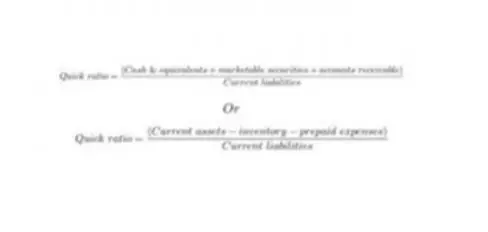Definition
The quick liquidity ratio (QR) is an indicator that shows the solvency of a business entity in the short term. This indicator shows whether it will be able to pay off its short-term liabilities at the expense of the most liquid assets: cash, short-term receivables, short-term financial investments. The quick ratio is used primarily by lenders to assess the business solvency when issuing loans. This liquidity indicator shows whether it has enough of its own funds to pay off debts.
Formula
Quick ratio is an indicator used in investment analysis. It is calculated based on the data from the Balance sheet of the enterprise by grouping the assets and liabilities. As you can see from the equations below, there are two ways to calculate this financial indicator. You can use either one for ratio calculation, depending on the information available or preference.
What does QR calculation tell?
The quick ratio shows the level of the company’s solvency in the near future. In this case, we can assume that the higher it is, the better standing the enterprise is. Yet, this is not so. First, the normal value of the indicator differs slightly from industry to industry. For example, for the service company, a value of 1.5 will be normal. It will be close to the current ratio (due to insignificant inventories). For a large machine-building plant, a QR greater than 1 will be sufficient.
Second, an excessively high quick ratio indicates that the company is receiving less profit because it inefficiently uses borrowed financing sources for its activities. If the quick ratio for a company from any industry becomes less than 0.7, this indicates an existence of a risk of loss of solvency: the amount of liquid assets no longer covers the company’s current liabilities.
Below are general guidelines for indicator norms.
- Up to 0.7
Loans are issued at a high-interest rate in the presence of significant collateral. There is a risk of losing investors.
- 0.7 to 1.0
This is optimal solvency, which creates opportunities for attracting additional funds through loans and investments.
- Over 1.0
The turnover of own funds invested in inventory and the company’s solvency are improving.
Summary
We have analyzed one of the three most widely used liquidity ratios – the quick ratio. In general, the essence of the ratio is how the company can pay off its debts with the help of highly liquid assets (cash). This indicator is used, as a rule, by lenders to determine the decision to grant a loan. If you use this indicator for your own management decisions, then it must be remembered that with a large value, the enterprise’s profitability decreases (liquidity and profitability have an inverse relationship). Here it is important to find a compromise between liquidity and profitability.


















